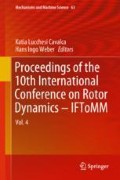Abstract
Automatic balancing devices are useful in order to balance rotating systems, which show variable unbalance configurations during operation, e.g. centrifuges, without the need for active components like controllers or actuators. The design of a ball-balancer consists of an annulus symmetric to the axis of rotation. It is filled with a viscous fluid and counterbalancing balls, which can move freely and oppose the rotor unbalance in the plane of the annulus when operated at supercritical speed. In order to determine the time for the balancing effect to be reached once the critical speed of the rotor is surpassed, sufficient modelling depth is needed to describe the movement of the balls during rotor run-up. Derived from transient simulations the influence of the balancer design parameters on the balancing process can be evaluated. A non-linear model of a ball-type automatic balancer is presented with which frictional forces based on Hertzian contact pressure and drag forces induced by the surrounding fluid are considered. Latter are obtained by solving the axisymmetric Navier-Stokes equations in the annular cavity by the method of finite differences. As a consequence, only one friction coefficient has to be quantified empirically. The model is included in multi-body simulations of tabletop centrifuges and the resulting angular movement of the balls is held against experimental data gained from video material of a balancer specimen with a transparent lid. Furthermore, the rotor deflection is compared with the simulation results.
Access this chapter
Tax calculation will be finalised at checkout
Purchases are for personal use only
References
Green K, Friswell MI, Champneys AR, Lieven NA (2005) The stability of automatic ball balancers. In: ISCORMA-3, Cleveland, Ohio
Sperling L, Ryzhik B, Duckstein H (2004) Single-plane auto-balancing of rigid rotors. Tech Mech 24(1):1–24
Inoue T, Ishida Y, Niimi H (2012) Vibration analysis of a self-excited vibration in a rotor system caused by a ball balancer. J Vib Acoust 134(2):021006. https://doi.org/10.1115/1.4005141
Ryzhik B, Duckstein H, Sperling L (2003) Automatic balancing of the unsymmetrical rigid rotor. PAMM 2(1):70–71
Ryzhik B, Sperling L, Duckstein H (2004) Auto-balancing of anisotropically supported rigid rotors. Tech Mech 24(1):37–50
Majewski T (1988) Position error occurrence in self balancers used on rigid rotors of rotating machinery. Mech Mach Theory 23(1):71–78. https://doi.org/10.1016/0094-114x(88)90011-0
Bolton JN (2010) Single- and dual-plane automatic balancing of an elastically-mounted cylindrical rotor with considerations of coulomb friction and gravity. Ph.D. thesis, Virginia Polytechnic Institute and State University. http://hdl.handle.net/10919/29946
Ishida Y, Matsuura T, Zhang XL (2012) Efficiency improvement of an automatic ball balancer. J Vib Acoust 134(2):021012. https://doi.org/10.1115/1.4005013
Jan CD, Chen JC (1997) Movements of a sphere rolling down an inclined plane. J Hydraul Res 35(5):689–706. https://doi.org/10.1080/00221689709498402
Spannan L, Daniel C, Woschke E (2017) Experimental study on the velocity dependent drag coefficient and friction in an automatic ball balancer. Tech Mech 37(1):62–68. https://doi.org/10.24352/UB.OVGU-2017-082
Green K, Champneys A, Friswell M (2006) Analysis of the transient response of an automatic dynamic balancer for eccentric rotors. Int J Mech Sci 48(3):274–293. https://doi.org/10.1016/j.ijmecsci.2005.09.014
Kim T, Na S (2013) New automatic ball balancer design to reduce transient-response in rotor system. Mech Syst Sig Process 37(1–2):265–275. https://doi.org/10.1016/j.ymssp.2013.01.016
Huang W, Chao C, Kang J, Sung C (2002) The application of ball-type balancers for radial vibration reduction of high-speed optic disk drives. J Sound Vib 250:415–430. https://doi.org/10.1006/jsvi.2001.3921
Spannan L, Daniel C, Woschke E (2017) Run-up simulation of automatic balanced rotors considering velocity-dependent drag coefficients. In: SIRM 2017 - 12th international conference on vibrations in rotating machines. https://doi.org/10.24352/UB.OVGU-2017-120. Published in Technische Mechanik 37(2–5), 442–449. ISSN: 2199-9244
Lopez JM, Shen J (1998) An efficient spectral-projection method for the navier-stokes equations in cylindrical geometries. J Comput Phys 139(2):308–326. https://doi.org/10.1006/jcph.1997.5872
Schumann U, Sweet RA (1976) A direct method for the solution of poisson’s equation with neumann boundary conditions on a staggered grid of arbitrary size. J Comput Phys 20(2):171–182. https://doi.org/10.1016/0021-9991(76)90062-0
Courant R, Friedrichs K, Lewy H (1967) On the partial difference equations of mathematical physics. IBM J Res Dev 11(2):215–234. https://doi.org/10.1147/rd.112.0215
Boyd JP (2001) Chebyshev and fourier spectral methods, 2nd edn. DOVER Publications, Mineola
Author information
Authors and Affiliations
Corresponding author
Editor information
Editors and Affiliations
Rights and permissions
Copyright information
© 2019 Springer Nature Switzerland AG
About this paper
Cite this paper
Spannan, L., Daniel, C., Woschke, E. (2019). Simulation of the Ball Kinetic in Ball-Type Automatic Balancing Devices by Solving the Axisymmetric Navier-Stokes Equations in Annular Cavities. In: Cavalca, K., Weber, H. (eds) Proceedings of the 10th International Conference on Rotor Dynamics – IFToMM. IFToMM 2018. Mechanisms and Machine Science, vol 63. Springer, Cham. https://doi.org/10.1007/978-3-319-99272-3_8
Download citation
DOI: https://doi.org/10.1007/978-3-319-99272-3_8
Published:
Publisher Name: Springer, Cham
Print ISBN: 978-3-319-99271-6
Online ISBN: 978-3-319-99272-3
eBook Packages: EngineeringEngineering (R0)

